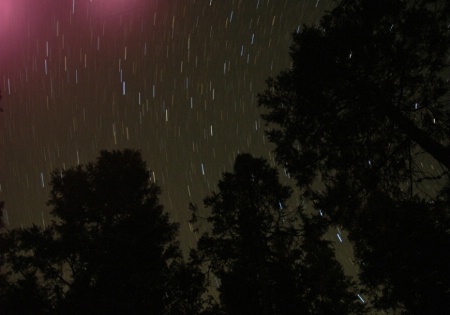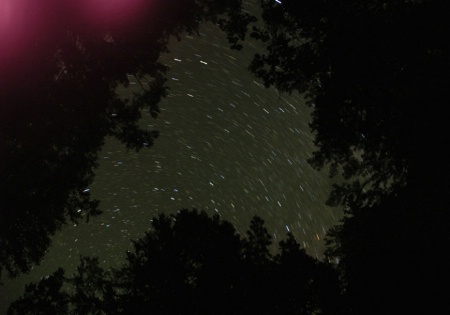
Ernest Aguayo |
|
What is wrong with these star trail shots?
|
|
|
|

Star Trails Attempt 1
f/3.5, 8.1 minutes, 18mm, 11:02pm, Yosemite National Park
Ernest Aguayo
|
|
|
|

Star Trails Attempt 2
f/3.5, 6.7 minutes, 18mm, 11:54pm, Yosemite National Park
Ernest Aguayo
|
|
|
|
Hi,I was experimenting with some long exposures to capture some star trails when I went camping. Unfortunately, as you can see in these photos, there is some weird red/pinkish flare showing up in the upper left-hand corner. What is causing this? I was using a lens hood, a tripod, and there wasn't any stray light from other campers I don't think. The only thing I could think it might be is the IR from the shutter remote since the receiver is on that side of the camera, but I didn't think that could show up on a photo. The flare doesn't show up the other times when I used the remote at night, but then again that was for much shorter exposures like 10-20 seconds. Any ideas? Other questions: 1. I think I was using an ISO of 800 on these shots to try to pick up the faint stars, but probably 200 is a better choice to get less grainy shots and because I am on a tripod anyway? 2. I was thinking to shoot at a big apperture to let in as much light as possible, but I should've instead been using something like f/22 to get more sharp detail to infinity, right? 3. I read in my D70 manual that the longest that the shutter can be held open for is 30 minutes in bulb mode: is that true? What if I want longer than that? Am I just out of luck? Any other tips from your experiences with these kinds of shots would also appreciated. Thanks for any and all help.
Ernest
August 18, 2005
|
|
|
Michael H. Cothran |
|
Ernest,
I'm not sure what caused the magenta flare, but looking at the image, I rather like it! Go figure!
I CAN offer a couple of tips on shooting star trails -
1. Use much longer shutter speeds. A few hours or so will produce nice stellular circle trails.
2. For the best circles, be sure your camera is aiming near or at the North Star.
Michael H. Cothran
www.mhcphoto.net
August 18, 2005
|
|
|
Will Turner |
|
Dunno what caused your flare, but a lot of us who like night and astrophotography prefer film cameras for this sort of work. You can leave a mechanical film camera on bulb for hours without using battery power. I use wide-angle lenses for star trails and general night scenes. For exposures over a minute or so, I like to use a mid-size aperture (f/5.6) as a constant and tailor exposure time to suit.
August 18, 2005
|
|
|
Kerry L. Walker |
|
Heck, Will. You're like me. You prefer a film camera for everything!
August 18, 2005
|
|
|
Bob Cammarata |
|
I will try to adress your concerns in order: 1) 200 would definately be better. The lowest ISO setting you can get away with is better,..(granularly speaking). 2) Don't worry about sharpness due to DOF when shooting the sky at infinity. Instead think about your lens' most efective (sharpest) aperture, which in most cases is two stops beyond the fastest setting.
When you are shooting a distant sky, everything will be in focus no matter what f-stop you choose.
(The only exception I can think of is if the forground elements you choose to include fall within the infinity-focus limitations of your lens.) 3) I'm not familiar with the D70 but if 30 minutes is as long as you can go,...does your camera have multiple-exposure capabilities?
If so, you can take several 30-minute exposures on the same frame.
Just make sure that your camera and tripod remains rock-solid and doesn't move between exposures. ...As to your flare issue,...light was getting to that corner from somewhere.
I doubt that the infra-red was the culprit unless its design keeps it illuminated long enough for the sensor to pick it up.
(Did you try any long exposure test without it?)
It might possibly be stray light filtering in from a bright planet out of frame, though that color tends to suggest that the trigger might indeed be to blame
August 18, 2005
|
|
|
David A. Bliss |
|
I will throw a couple of pennies in here. Bob is right, use the lowest ISO setting possible. By nature, a long shutter speed will add noise, so you want to use the ISO setting with the least amount of "grain." As for DOF, you definitely don't want to use a very small aperture, because not enough light will hit the sensor, and you won't have many bright trails, but you also don't want too shallow a DOF either. Don't set the camera on infinity (I know this one from experience). Go for the hyperfocal setting, to keep as much foreground in focus as possible. If you don't have any foreground, only stars, infinity would be fine. The flare on the picture comes from the D70's CCD heating up, which causes heat distortion. That is the fatal flaw of using a CCD as opposed to a CMOS sensor (like Canon uses). I agree that you need to use a longer shutter speed, but you don't need to go as long as a couple of hours. It depends on what you are looking for. This shot was 22 minutes. I do think I am going to dust off my EOS 620 (and used canned air to do it!! ;-P sorry, different thread ;-) and try some longer shots with film. Cleaning up the noise from the digital is a pain.
August 18, 2005
|
|
|
Sharon Day |
|
Thirty minutes is the limit with the D70 and it has no multiple exposure capabilities. I've been intending to try some star trails myself. I live in the city so it's hard to find stars without driving quite a ways. Now I'm even more interested. I hadn't heard the sensors heat up. I've seen this done with the D100 without red or pinkish flares. I don't know why the D70 would be any different.
August 19, 2005
|
|
|
Ernest Aguayo |
|
Thanks for all this great info, folks. It helps a ton! I do have an old SLR that I'll dig up to try this again with film using some of the tips you mentioned. Any brand recommendations? Good call on deciphering what that flare was: that's too bad it's just inherent of having a CCD. I happened to be in a camera shop today and the guy behind the counter confirmed this theory but was surprised: he said a D70 shouldn't be *this* bad with only an 8 min exposure. Since it's still under warranty, I called Nikon and they said that's probably what it was, but didn't say they could do anything about it which I think is a little bogus if they say in the manual that the shutter can be open for 30 minutes. Argh! Ernest
August 19, 2005
|
|
|
|
Log in to respond or ask your own question.
|